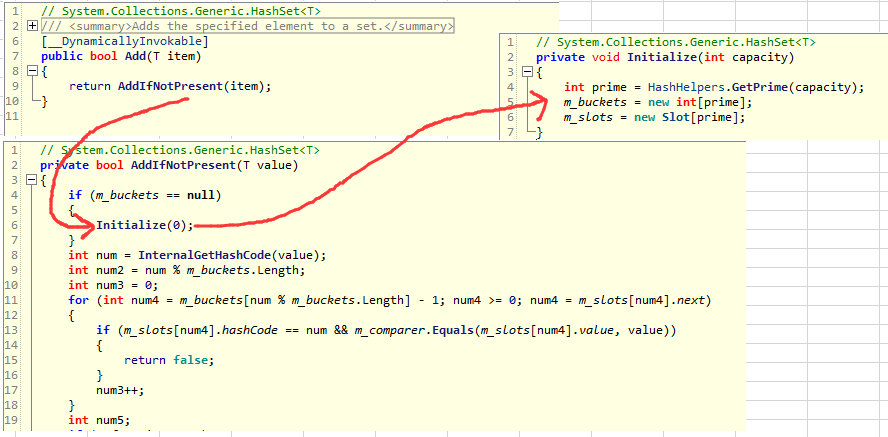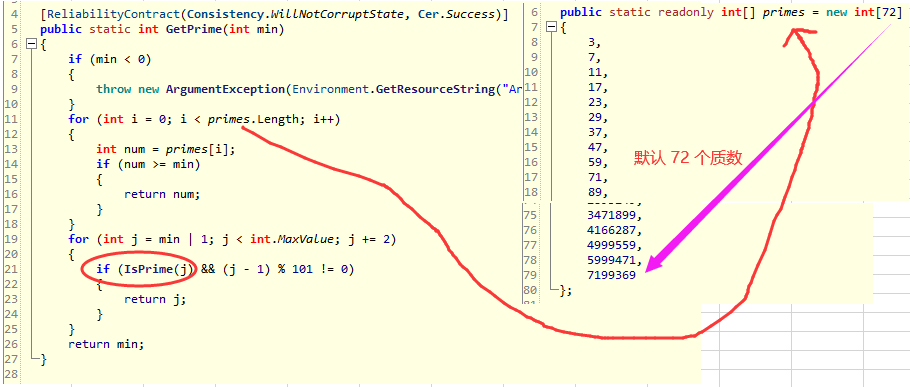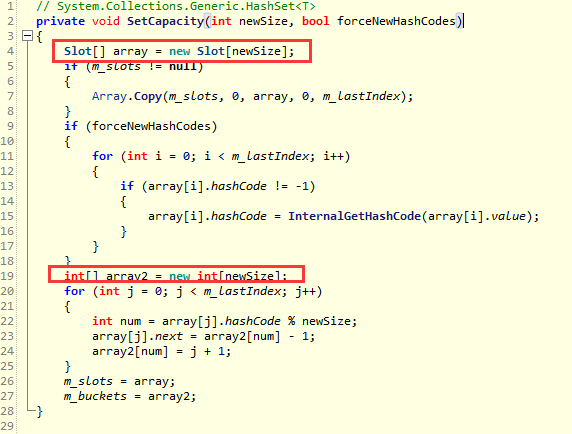c# HashSet 扩容机制 c# HashSet的扩容机制需要注意的
一线码农 人气:0一:背景
1. 讲故事
自从这个纯内存项目进了大客户之后,搞得我现在对内存和CPU特别敏感,跑一点数据内存几个G的上下,特别没有安全感,总想用windbg抓几个dump看看到底是哪一块导致的,是我的代码还是同事的代码? 很多看过我博客的老朋友总是留言让我出一套windbg的系列或者视频,我也不会呀,没办法,人在江湖飘,迟早得挨上几刀,逼着也得会几个花架子😄😄😄,废话不多说,这一篇就来看看 HashSet 是如何扩容的。
二:HashSet的扩容机制
1. 如何查看
了解如何扩容,最好的办法就是翻看HashSet底层源码,最粗暴的入口点就是 HashSet.Add 方法。

从图中可以看到最后的初始化是用 Initialize 的,而且里面有这么一句神奇的代码: int prime = HashHelpers.GetPrime(capacity);,从字面意思看是获取一个质数,哈哈,有点意思,什么叫质数? 简单说就是只能被 1 和 自身 整除的数就叫做质数,那好奇心就来了,一起看看质数是怎么算的吧! 再次截图。

从图中看,HashSet底层为了加速默认定义好了 72 个质数,最大的一个质数是 719w,换句话就是说当元素个数大于 719w 的时候,就只能使用 IsPrime 方法动态计算质数,如下代码:
public static bool IsPrime(int candidate)
{
if ((candidate & 1) != 0)
{
int num = (int)Math.Sqrt(candidate);
for (int i = 3; i <= num; i += 2)
{
if (candidate % i == 0)
{
return false;
}
}
return true;
}
return candidate == 2;
}
看完了整个流程,我想你应该明白了,当你第一次Add的时候,默认的空间占用是 72 个预定义中最小的一个质数 3,看过我之前文章的朋友知道List的默认大小是4,后面就是简单粗暴的 * 2 处理,如下代码。
private void EnsureCapacity(int min)
{
if (_items.Length < min)
{
int num = (_items.Length == 0) ? 4 : (_items.Length * 2);
}
}
2. HashSet 二次扩容探究
当HashSet的个数达到3之后,很显然要进行二次扩容,这一点不像List用一个 EnsureCapacity 方法搞定就可以了,然后细看一下怎么扩容。

public static int ExpandPrime(int oldSize)
{
int num = 2 * oldSize;
if ((uint)num > 2146435069u && 2146435069 > oldSize)
{
return 2146435069;
}
return GetPrime(num);
}
从图中可以看到,最后的扩容是在 ExpandPrime 方法中完成的,流程就是先 * 2, 再取最接近上限的一个质数,也就是 7 ,然后将 7 作为 HashSet 新的Size,如果你非要看演示,我就写一小段代码证明一下吧,如下图:

2. 您嗅出风险了吗?
<1> 时间上的风险
为了方便演示,我把 72 个预定义的最后几个质数显示出来。
public static readonly int[] primes = new int[72]
{
2009191,
2411033,
2893249,
3471899,
4166287,
4999559,
5999471,
7199369
};
也就是说,当HashSet的元素个数为 2893249 的时候触发扩容变成了 2893249 * 2 => 5786498 最接近的一个质数为:5999471,也就是 289w 暴增到了 599w,一下子就是 599w -289w = 310w 的空间虚占,这可是增加了两倍多哦,吓人不? 下面写个代码验证下。
static void Main(string[] args)
{
var hashSet = new HashSet<int>(Enumerable.Range(0, 2893249));
hashSet.Add(int.MaxValue);
Console.Read();
}
0:000> !clrstack -l
000000B8F4DBE500 00007ffaf00132ae ConsoleApplication3.Program.Main(System.String[]) [C:\4\ConsoleApp1\ConsoleApp1\Program.cs @ 16]
LOCALS:
0x000000B8F4DBE538 = 0x0000020e0b8fcc08
0:000> !DumpObj /d 0000020e0b8fcc08
Name: System.Collections.Generic.HashSet`1[[System.Int32, System.Private.CoreLib]]
Size: 64(0x40) bytes
File: C:\Program Files\dotnet\shared\Microsoft.NETCore.App\5.0.0-preview.5.20278.1\System.Collections.dll
Fields:
MT Field Offset Type VT Attr Value Name
00007ffaf0096d10 4000017 8 System.Int32[] 0 instance 0000020e2025e9f8 _buckets
00007ffaf00f7ad0 4000018 10 ...ivate.CoreLib]][] 0 instance 0000020e2bea1020 _slots
00007ffaeffdf828 4000019 28 System.Int32 1 instance 2893250 _count
0:000> !DumpObj /d 0000020e2025e9f8
Name: System.Int32[]
Size: 23997908(0x16e2dd4) bytes
Array: Rank 1, Number of elements 5999471, Type Int32 (Print Array)
Fields:
None

而且最重要的是,这里是一次性扩容的,而非像redis中实现的那样渐进式扩容,时间开销也是大家值得注意的

<2> 空间上的风险
这个有什么风险呢?可以看一下:289w 和 599w 两个HashSet的占用空间大小,这也是我最敏感的。
static void Main(string[] args)
{
var hashSet1 = new HashSet<int>(Enumerable.Range(0, 2893249));
var hashSet2 = new HashSet<int>(Enumerable.Range(0, 2893249));
hashSet2.Add(int.MaxValue);
Console.Read();
}
0:000> !clrstack -l
OS Thread Id: 0x4a44 (0)
000000B1B4FEE460 00007ffaf00032ea ConsoleApplication3.Program.Main(System.String[]) [C:\4\ConsoleApp1\ConsoleApp1\Program.cs @ 18]
LOCALS:
0x000000B1B4FEE4B8 = 0x000001d13363cc08
0x000000B1B4FEE4B0 = 0x000001d13363d648
0:000> !objsize 0x000001d13363cc08
sizeof(000001D13363CC08) = 46292104 (0x2c25c88) bytes (System.Collections.Generic.HashSet`1[[System.Int32, System.Private.CoreLib]])
0:000> !objsize 0x000001d13363d648
sizeof(000001D13363D648) = 95991656 (0x5b8b768) bytes (System.Collections.Generic.HashSet`1[[System.Int32, System.Private.CoreLib]])
可以看到, hashSet1的占用: 46292104 / 1024 / 1024 = 44.1M, hashSet2 的占用 : 95991656 / 1024 / 1024 = 91.5M,一下子就浪费了: 91.5 - 44.1 = 47.4M。
如果你真以为仅仅浪费了 47.4M 的话,那你就大错特错了,不要忘了底层在扩容的时候,使用新的 size 覆盖了老的 size,而这个 老的 size 集合在GC还没有回收的时候会一直占用堆上空间的,这个能听得懂吗? 如下图:

要验证的话可以用 windbg 去托管堆上抓一下 Slot[] m_slots 和 int[] m_buckets 两个数组,我把代码修改如下:
static void Main(string[] args)
{
var hashSet2 = new HashSet<int>(Enumerable.Range(0, 2893249));
hashSet2.Add(int.MaxValue);
Console.Read();
}
0:011> !dumpheap -stat
00007ffaf84f7ad0 3 123455868 System.Collections.Generic.HashSet`1+Slot[[System.Int32, System.Private.CoreLib]][]

这里就拿 Slot[] 说事,从上面代码可以看到,托管堆上有三个 Slot[] 数组,这就有意思了,怎么有三个哈,是不是有点懵逼,没关系,我们将三个 Slot[] 的地址找出来,一个一个看。
0:011> !DumpHeap /d -mt 00007ffaf84f7ad0
Address MT Size
0000016c91308048 00007ffaf84f7ad0 16743180
0000016c928524b0 00007ffaf84f7ad0 34719012
0000016ce9e61020 00007ffaf84f7ad0 71993676
0:011> !gcroot 0000016c91308048
Found 0 unique roots (run '!gcroot -all' to see all roots).
0:011> !gcroot 0000016c928524b0
Found 0 unique roots (run '!gcroot -all' to see all roots).
0:011> !gcroot 0000016ce9e61020
Thread 2b0c:
0000006AFAB7E5F0 00007FFAF84132AE ConsoleApplication3.Program.Main(System.String[]) [C:\4\ConsoleApp1\ConsoleApp1\Program.cs @ 15]
rbp-18: 0000006afab7e618
-> 0000016C8000CC08 System.Collections.Generic.HashSet`1[[System.Int32, System.Private.CoreLib]]
-> 0000016CE9E61020 System.Collections.Generic.HashSet`1+Slot[[System.Int32, System.Private.CoreLib]][]
从上面可以看到,我通过 gcroot 去找这三个地址的引用根,有两个是没有的,最后一个有的自然就是新的 599w 的size,对不对,接下来用 !do 打出这三个地址的值。
0:011> !do 0000016c91308048 Name: System.Collections.Generic.HashSet`1+Slot[[System.Int32, System.Private.CoreLib]][] Size: 16743180(0xff7b0c) bytes Array: Rank 1, Number of elements 1395263, Type VALUETYPE (Print Array) Fields: None 0:011> !do 0000016c928524b0 Name: System.Collections.Generic.HashSet`1+Slot[[System.Int32, System.Private.CoreLib]][] Size: 34719012(0x211c524) bytes Array: Rank 1, Number of elements 2893249, Type VALUETYPE (Print Array) Fields: None 0:011> !do 0000016ce9e61020 Name: System.Collections.Generic.HashSet`1+Slot[[System.Int32, System.Private.CoreLib]][] Size: 71993676(0x44a894c) bytes Array: Rank 1, Number of elements 5999471, Type VALUETYPE (Print Array) Fields: None
从上面的 Rank 1, Number of elements 信息中可以看到,原来托管堆不仅有扩容前的Size :2893249,还有更前一次的扩容Size: 1395263,所以按这种情况算: 托管堆上的总大小近似为: 23.7M + 47.4M + 91.5M = 162.6M,我去,不简单把。。。 也就是说:托管堆上有 162.6 - 91.5 =71.1M 的未回收垃圾 ➕ 刚才的 47.4M 的空间虚占用,总浪费为:118.5M,但愿我没有算错。。。
3. 有解决方案吗?
在List中大家可以通过 Capacity 去控制List的Size,但是很遗憾,在 HashSet 中并没有类似的解决方案,只有一个很笨拙的裁剪方法: TrimExcess,用于将当前Size扩展到最接近的 质数 值, 如下代码所示:
public void TrimExcess()
{
int prime = HashHelpers.GetPrime(m_count);
Slot[] array = new Slot[prime];
int[] array2 = new int[prime];
int num = 0;
for (int i = 0; i < m_lastIndex; i++)
{
if (m_slots[i].hashCode >= 0)
{
array[num] = m_slots[i];
int num2 = array[num].hashCode % prime;
array[num].next = array2[num2] - 1;
array2[num2] = num + 1;
num++;
}
}
}
应用到本案例就是将 289w 限制到 347w,仍然有 58w的空间占用。 如下图:

三: 总结
HashSet的时间和空间上虚占远比你想象的大很多,而且实占也不小,因为底层用到了双数组 m_slots 和 m_buckets,每个Slot还有三个元素: struct Slot { int hashCode;internal int next;internal T value; }所以了解完原理之后谨慎着用吧。
加载全部内容